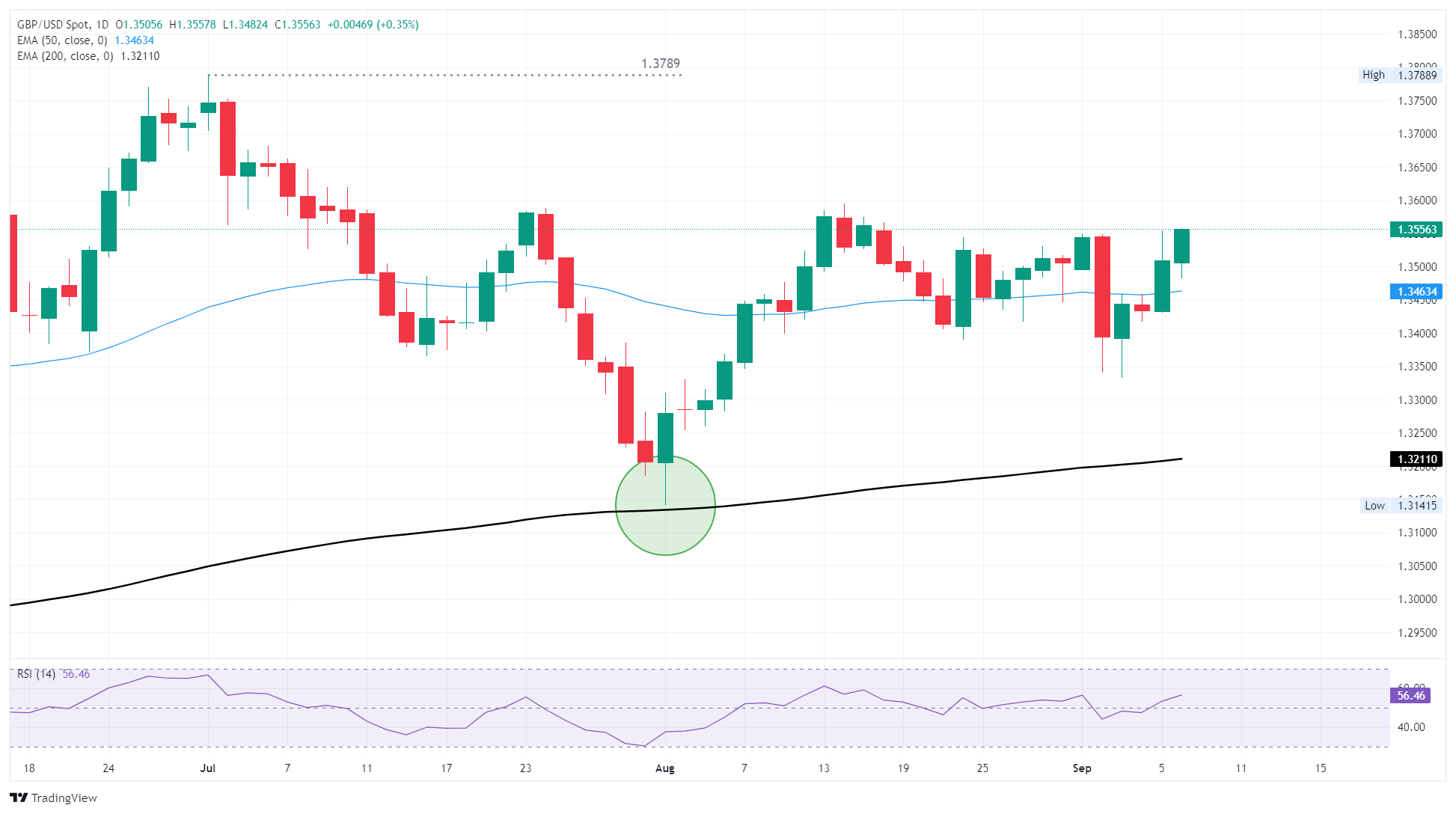GBP/USD continues to climb ahead of key US inflation data

- GBP/USD extended gains on Monday, climbing another 0.35%.
- Market sentiment is holding on the high side as investors bet on Fed rate cuts.
- US inflation data due this week could mar investor sentiment ahead of the Fed’s next rate call.
GBP/USD rose further on Monday, extending another 0.35% to recapture chart territory north of 1.3550. General market sentiment is banking on an interest rate cut at the Federal Reserve’s (Fed) next meeting on September 17, thanks to rapidly deflating employment figures in the United States (US). However, the latest batch of US Consumer Price Index (CPI) inflation is due this week, and could throw a wrench in interest rate expectations.
GBP/USD is taking a fresh run at technical resistance just below the 1.3600 handle, and technical oscillators plus ongoing support from the 50-day Exponential Moving Average (EMA) are warning that a bullish push could have room to run. However, price action has had a hard time getting back above 1.3600, and could see a fresh swing low if the near-term technical ceiling holds.
US inflation upswing remains key risk for rate cut bets
A general lack of United Kingdom (UK) data leaves the US docket in the driver’s seat this week. French Prime Minister Francois Bayou lost a confidence vote within the French Parliament this week; while French politics will have little direct impact on the Pound Sterling (GBP), the general uneasy sentiment that has gripped global politics is no stranger to the UK, and could see elevated risk flight at the drop of a hat.
US Producer Price Index (PPI) inflation data is due on Tuesday, but the key numbers this week will be Thursday’s CPI inflation update. Investors are expecting a slight easing in core PPI to 3.5% YoY from 3.7%, while traders are hoping that August’s headline CPI print will only rise to 2.9% from 2.7%.
GBP/USD daily chart

Pound Sterling FAQs
The Pound Sterling (GBP) is the oldest currency in the world (886 AD) and the official currency of the United Kingdom. It is the fourth most traded unit for foreign exchange (FX) in the world, accounting for 12% of all transactions, averaging $630 billion a day, according to 2022 data. Its key trading pairs are GBP/USD, also known as ‘Cable’, which accounts for 11% of FX, GBP/JPY, or the ‘Dragon’ as it is known by traders (3%), and EUR/GBP (2%). The Pound Sterling is issued by the Bank of England (BoE).
The single most important factor influencing the value of the Pound Sterling is monetary policy decided by the Bank of England. The BoE bases its decisions on whether it has achieved its primary goal of “price stability” – a steady inflation rate of around 2%. Its primary tool for achieving this is the adjustment of interest rates. When inflation is too high, the BoE will try to rein it in by raising interest rates, making it more expensive for people and businesses to access credit. This is generally positive for GBP, as higher interest rates make the UK a more attractive place for global investors to park their money. When inflation falls too low it is a sign economic growth is slowing. In this scenario, the BoE will consider lowering interest rates to cheapen credit so businesses will borrow more to invest in growth-generating projects.
Data releases gauge the health of the economy and can impact the value of the Pound Sterling. Indicators such as GDP, Manufacturing and Services PMIs, and employment can all influence the direction of the GBP. A strong economy is good for Sterling. Not only does it attract more foreign investment but it may encourage the BoE to put up interest rates, which will directly strengthen GBP. Otherwise, if economic data is weak, the Pound Sterling is likely to fall.
Another significant data release for the Pound Sterling is the Trade Balance. This indicator measures the difference between what a country earns from its exports and what it spends on imports over a given period. If a country produces highly sought-after exports, its currency will benefit purely from the extra demand created from foreign buyers seeking to purchase these goods. Therefore, a positive net Trade Balance strengthens a currency and vice versa for a negative balance.







